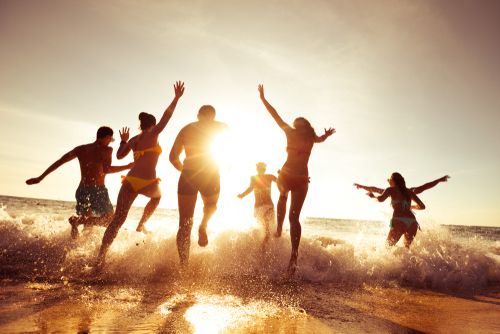8 woods to visit in autumn: Destinations in Spain

I went to the woods because I wished to live deliberately, to front only the essential facts of life, and see if I could not learn what it had to teach, and not, when I came to die, discover that I had not lived.
Today, we begin our post with a beautiful quote by Henry David Thoreau. The excuse, the arrival of autumn. Can you think of a better place than a forest in the middle of nature to enjoy this season? For this reason, we present a compilation with the top 8 forests to visit in autumn in Spain. We hope you enjoy them.
1. Irati Forest (Navarra)

Irati Forest is the largest forest mass in the Foral Community of Navarra and the second largest beech-fir forest in Europe (after the Black Forest in Germany). It is a beautiful forest whose soil is covered with a reddish mantle when the leaves fall. Trees and vegetation turn the same color, giving rise to an idyllic autumnal scene. In addition, in the Irati Forest we can find 16 marked paths for hiking enthusiasts. Just don't forget to wear hiking boots and bring a camera to immortalize the landscape.
2. Muniellos Forest (Asturias)
Located within Fuentes del Narcea, Degaña and Ibias Natural Park in Asturias, Muniellos Forest is the largest oak grove in Spain and one of the best preserved in all of Europe. Stroll into the Muniellos Forest and discover one of the best outdoor settings to visit in autumn. The environment, home to many legends of Astur mythology, maintains a very intense green color (thanks to the holly) that mixes with the gold and reddish tones from the fallen leaves of beeches, chestnut trees, and oaks. Keep in mind that only a limited number of people are allowed into the forest each day, so you’ll need to request permission before you go using the Principality of Asturias website.
3. Ordesa Valley (Aragon)
Ordesa Valley is one of the best places for rural tourism in Huesca. Located in the Aragonese Pyrenees, Ordesa and Monteperdido National Park undergoes a beautiful transformation around this time of year: beeches, birches, maples, and ash trees give rise to a colorful spectacle when the fall arrives. A landscape dotted with yellow and reddish colors makes this area worth visiting to enjoy some of its hiking trails. Wrap up and wear appropriate footwear so you don't miss one of the ideal places to travel in the fall.
4. Gorbeia Natural Park (Basque Country)

Gorbeia is the largest Natural Park in the whole region, known for its lush vegetation. It is embedded in a magical environment, especially at this time of the year, due to the golden and copper-colored tones that paint the landscape. Prepare a getaway now and enjoy unique places like the Akaitz beech woods, the limestone pavement of Pardarri, the Arritzaga Valley, and the cirque glaciar in Pardelutz. At Gorbeia Natural Park, you will discover an idyllic site straight out of a fairy tale, the perfect place to visit in the fall.
5. Aran Valley (Lleida)
Located in the Catalan Pyrenees, the Aran Valley is one of the best destinations to travel in autumn. After the summer, the first snowfalls begin on the mountain tops, which cover some of the highest peaks in Spain with an immaculate white mantle. In addition, the yellow, maroon, and orange shades of deciduous trees (beech and centenary oaks) make the valley’s forests some of the most attractive to enjoy the cozy colors of this season. We recommend you dress warmly and bring the appropriate gear to avoid being cold and to be able to walk comfortably around these incredible landscapes.
6. Faedo de Ciñera Beech Woods (León)

Although it is small, the Faedo de Ciñera holds the title of The Best Cared For Forest in Spain. This very special forest is located in the Central Leonese Mountains, where it is said that a witch named Haeda, guardian and protector of the place, dwells. Let your mind wander on paths surrounded by trees and stop to nap by the stream that bears the same name: you will discover one of the most charming areas to explore in autumn.
7. Ambroz Valley (Cáceres)

Located to the south of the province of Cáceres, between Las Hurdes and the Jerte Valley, we find the Ambroz River Valley. With its chestnut trees and oak woods, it is one of the best places to enjoy the colors of autumn. In fact, the locals even have a fiesta dedicated to this season: "Magic Autumn." It is a Festival of National Tourist Interest that is celebrated annually between the months of October and December with different outdoor activities: hiking trails, exhibitions, local products and food markets, craft fairs, dances, competitions, and much more make the Ambroz Valley the perfect place to have fun with family and friends.
8. Tejeda Negra Beech Forest (Guadalajara)
Tejeda Negra is the southernmost beech forest in all of Europe, located in the province of Guadalajara. Thanks to its deciduous trees, the best time to visit the Tejera Negra Beech Forest is autumn. The color variety is spectacular, and if you go with an expert, you can also enjoy the many species of mushrooms that you can find there. The hiking trails around the area are not very difficult and are truly beautiful. It is advisable to book in advance as a limited number of people are allowed entry.
We hope you enjoyed the post and, above all, that you organize a getaway very soon to experience the essence of autumn in the middle of nature.





























